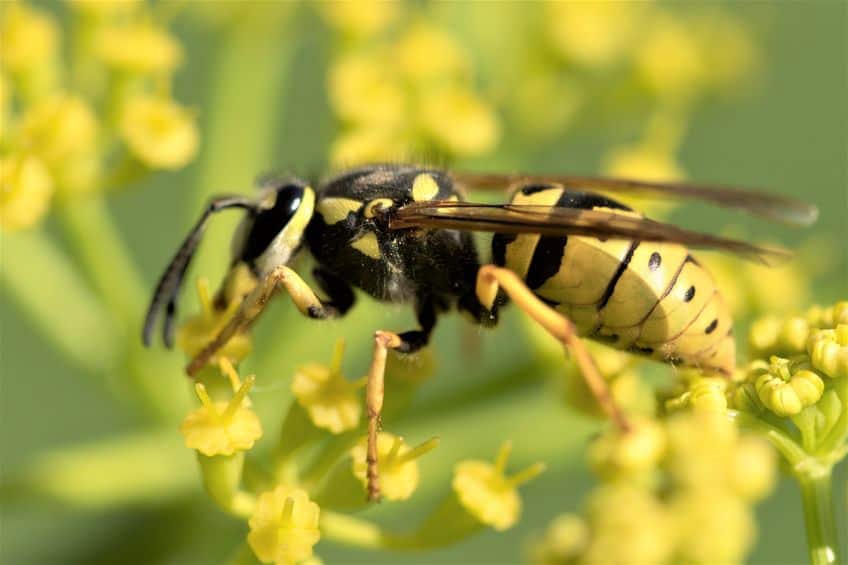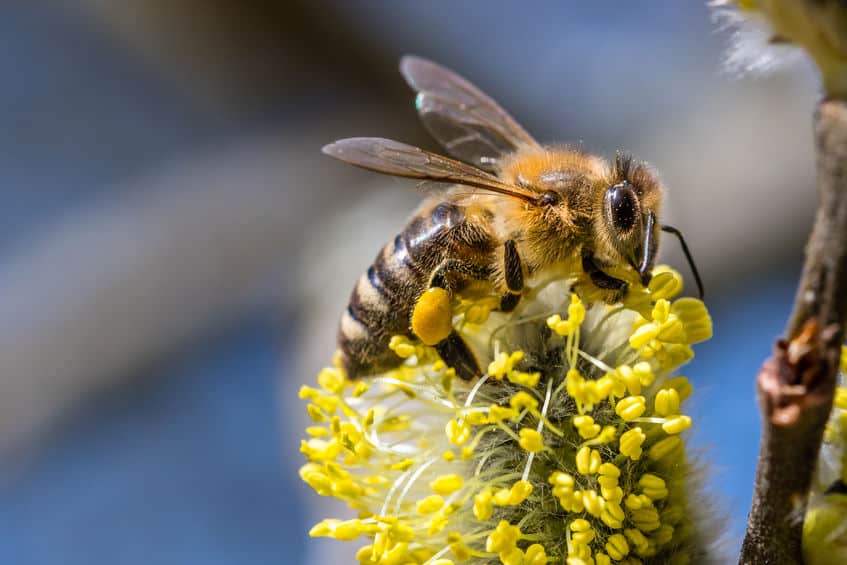The differences between bees and wasps are nuanced but some generalities can be made.
Wasps often have a cut waist whereas bees do not. Bees are rounder in appearance. Also, wasps are omnivorous and are predators, while bees are mostly vegetarian. Social bees will make hives from wax, whereas social wasps make nests from wood pulp. While both wasps and bees pollinate, bees are more efficient due to having more body hair. Some species of both wasps and bees produce honey.
The huge range of wasp and bee species means that there are caveats to most comparisons.
Honey
It is a common perception that bees make honey and wasps do not. This is not true. Only honey bees make honey with the vast majority of bees not doing so. Also, some wasps do make honey. The Mexican honey wasp does produce honey. This is not a clear difference then between wasps and bees. Read more about honey bees here.
Diet
Wasps are omnivores and prey on insects to feed their larvae with some also sucking fluids from their prey. The vast majority of bees are vegetarian feeding on nectar and pollen. There are some bees, however, that do consume meat. Vulture bees are stingless bees found in North America which feed on rotting meat. Wasps also primarily feed on nectar in the same way that bees do.
Colonies
Both wasps and bees can be divided into social and solitary. The social species both live in colonies but these wasps build nests fashioned out of wood pulp in the form of paper nests, whereas many bees will make hives out of wax. Solitary bees and wasps can be very similar in behavior with both making burrows. Wasps are far more likely to be parasitoids, however, with their larvae being carnivorous. Bee larvae are far more likely to consume pollen. Parasitoid wasps paralyze a host animal with their sting before providing that host as a living source of food for its larvae to consume. One example is that of the tarantula hawk wasp which paralyzes tarantulas. The tarantulas are then eaten alive by their larvae. Read more about the tarantula hawk here.
Sting
Some bees such as honey bees have barbed stingers meaning that they can only sting once and will then lose their sting. Other bees, however, can sting multiple times such as bumblebees. Most wasps do not have barbed stings, again meaning they can sting multiple times. A few wasp species are known to have barbed stings, however, including some species of warrior wasp.

Shape
Many wasp species have distinctive ‘wasp waists’ which allow them to move their abdomen to face almost any direction. This is very useful when preying on insects and allows the stinger to be maneuvered into position. Bees do not have this flexibility. Some wasp species such as hornets tend to be much fuller in body though and can resemble large bees. Read more about hornets here.

Communication
Honey bees tend to be unique in their communication in that they use a special dance to communicate the location of food with each other. This behavior is not seen in other bee species, however, and wasps do not communicate in this way. All species do use pheromones though as a way of communicating. Read more about bees dancing here.
Aggressiveness
Wasps as predators tend to be more aggressive than bees. Species such as yellow-jackets are more likely to inflict a sting than bees are. Hornets are also regarded as more aggressive than bees and are actually a danger to honey bees. They will attack honey bee hives and can wipe out an entire colony to get to the honey and larvae within. Read more about the aggressiveness of wasps here.
Swarming
Some wasp and bee species will swarm. Swarming is when they move on mass to relocate a colony to a new location. Honey bees are well known for this behavior, but warrior wasps are also known for their ability to swarm if a colony is under threat from fire or army ants. Read more about warrior wasps here.
Pollination
Wasps and bees both consume nectar and so both pollinate plants. Bees are generally hairier than wasps and so are more efficient pollinators. Wasps due to their sheer numbers do play an important role in pollination. Wasps are not big consumers of pollen, unlike bees.
Summary
The diverse range of wasp and bee species mean that there are many similar traits found among wasps and bees. Generally bees are rounder, do not consume meat or prey on other insects and are more efficient pollinators.
